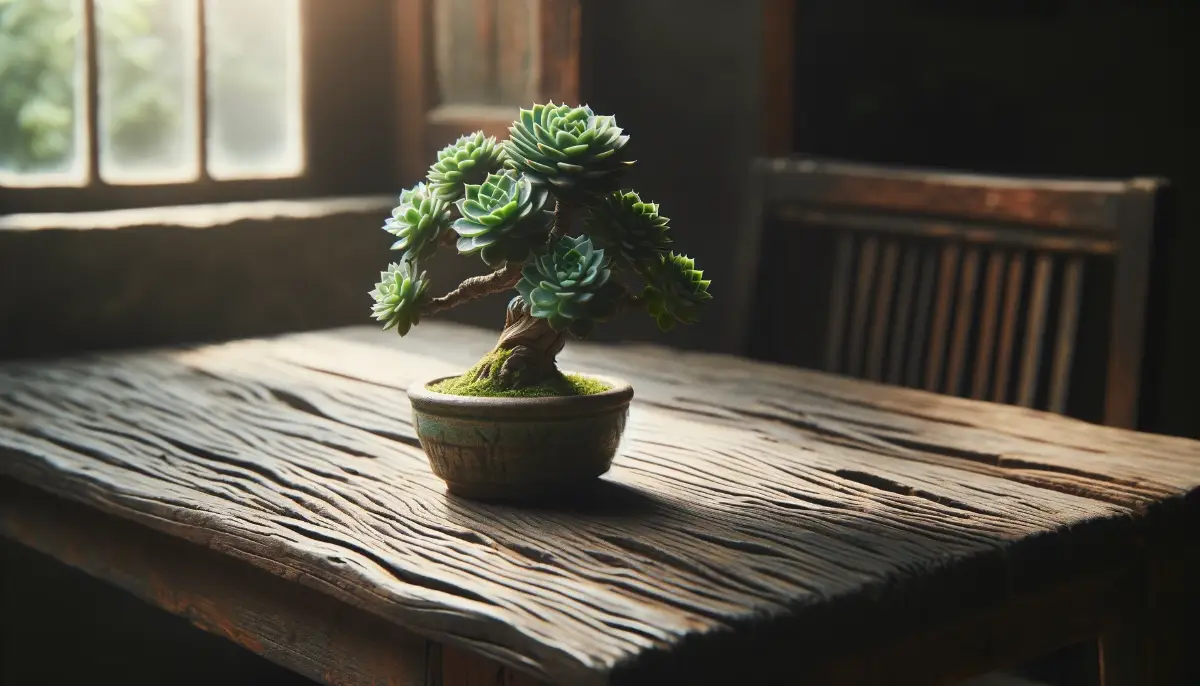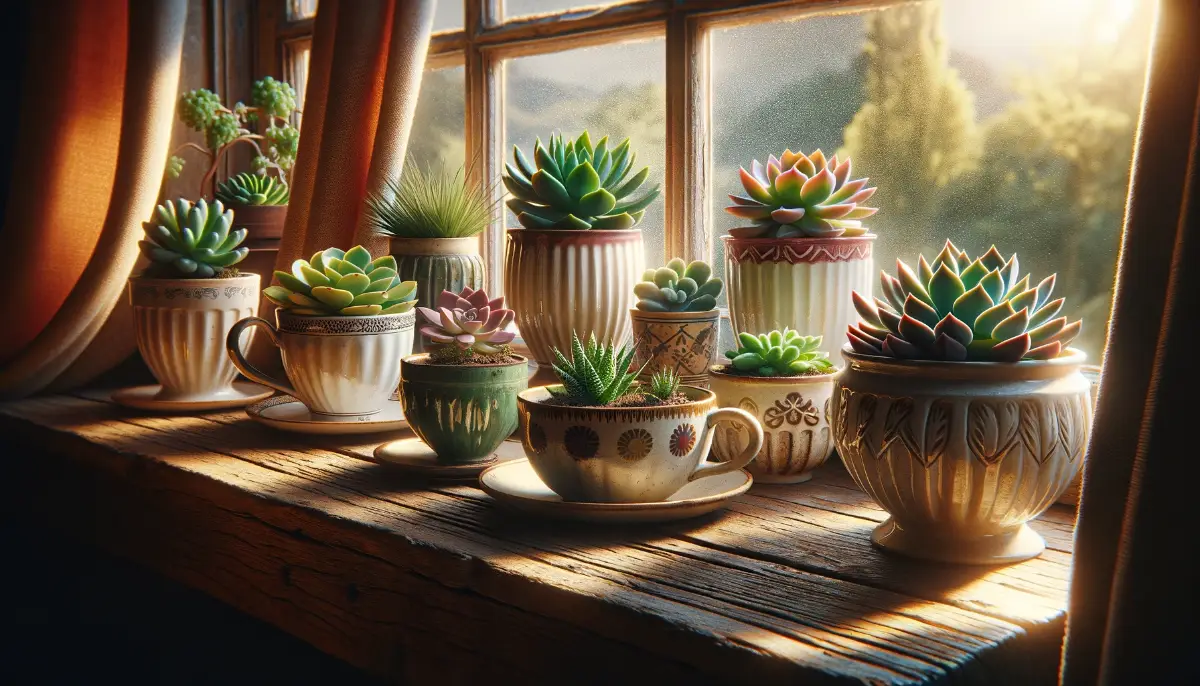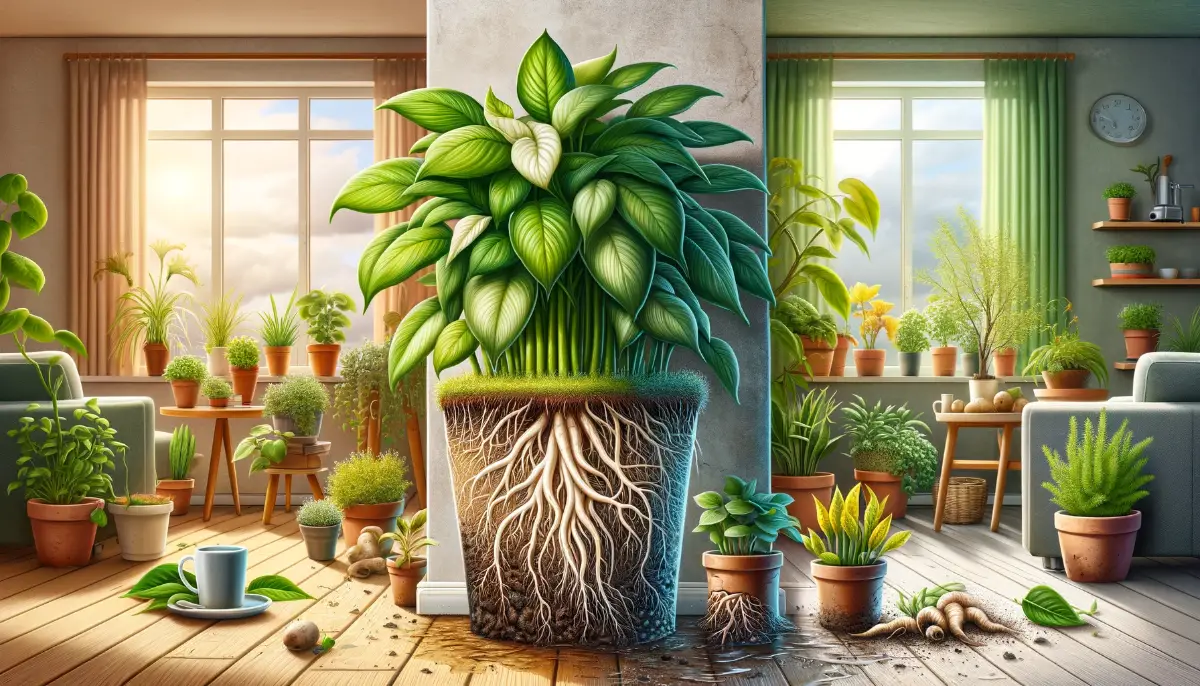Grow at Home
Among the various options for indoor plants, cactus stand out due to their striking forms, minimal care requirements, and ability to thrive in less-than-ideal conditions. Ideal for those with busy lifestyles or less-than-green thumbs, cactus can bring a touch of the exotic to any indoor setting.
Their varied shapes and sizes, combined with their resilience and low water needs, make them particularly suited for indoor cultivation. Whether you’re looking to add a statement piece to your living room or a small, decorative touch to a sunny windowsill, there’s a cactus to suit every indoor environment.
Choosing the Right Cactus for Your Home
When choosing the right cactus for your home, several factors come into play to ensure you select varieties that will not only survive but thrive in your indoor environment. Here are key considerations to help you pick the best indoor cactus:
Light Requirements
Most cacti require plenty of sunlight to flourish. Typically, they thrive in conditions where they can receive several hours of direct sunlight daily. Window Sills that face south or west are ideal spots for cactus as they provide ample sunlight.
For cactus varieties like the Christmas Cactus, which prefer indirect light, an east-facing window can be suitable.
Size and Growth
Consider the available space and the mature size of the cactus. Some species, such as the Saguaro and the Mexican Fence Post Cactus, can grow quite tall and might not be suitable for every indoor setting due to their size.
Compact varieties like the Feather Cactus or Bunny Ear Cactus are more suited for smaller spaces or tabletop displays.
Watering Needs
cactus are generally low-maintenance in terms of watering requirements. However, the frequency and amount of water needed can vary significantly between species.
Most cactus prefer the “soak and dry” method, where the soil is allowed to dry out completely between waterings. It’s crucial to use pots with good drainage and avoid over-watering to prevent root rot.
Aesthetic Preference
cactus come in various shapes, colors, and sizes, offering numerous options to match your home decor style. Some cactus, like the striking Coral Cactus, have a sculptural quality that can serve as a focal point in a room. Others, such as the unassuming Star Cactus, blend more subtly into their surroundings.
Pet and Child Safety
Some cactus, like the Coral Cactus, are toxic and have sharp spines that can be dangerous to pets and children. It’s important to choose non-toxic varieties if pets or small children are in the home and to place spiny cactus out of reach.
By considering these factors, you can choose a cactus or several that fits well with your lifestyle and home environment, ensuring both aesthetic appeal and plant health.
Detailed Profiles of Popular Indoor Cactus
Christmas Cactus (Schlumbergera)
The Christmas Cactus (Schlumbergera) is a popular indoor cactus, renowned not only for its ease of care but also for its vibrant seasonal blooms. Unlike typical desert cactus, the Christmas Cactus does not thrive in direct sunlight and arid environments. Instead, it prefers conditions that mimic its native Brazilian rainforest habitats.
Characteristics
- Appearance: The Christmas Cactus has flat, segmented leaves that are more reminiscent of leaves than traditional cactus spines. The edges of these segments are slightly rounded, which differentiates it from its Thanksgiving and Easter cactus cousins, which have more pointed lobes.
- Flowers: This cactus is famous for its colorful flowers that can range from pink to red, purple, or white, which typically bloom around the Christmas season, hence its name.
Care Guidelines
- Light: It thrives in bright but indirect light. Direct sunlight can cause the leaves to burn, whereas too little light might prevent it from flowering effectively.
- Watering: The Christmas Cactus requires more regular watering than most cactus, especially during its growing season in the spring and summer. The soil should be kept evenly moist, and the plant should be allowed to dry out slightly between waterings. Overwinter, watering should be reduced.
- Temperature: Prefers cooler temperatures and can benefit from being kept in a cooler spot during the winter months, ideally between 50 and 60 degrees Fahrenheit, to encourage blooming.
- Soil: It needs well-draining soil rich in organic matter. A standard houseplant or cactus mix amended with compost is suitable.
Propagation and Repotting
- Propagation: Propagation is typically done through leaf cuttings where a leaf segment is allowed to dry for a few hours before being planted in moist soil.
- Repotting: While it does not need frequent repotting, doing so every couple of years can be beneficial. The best time to repot is right after flowering, in late winter or early spring, which helps refresh the soil and provide room for growth.
The Christmas Cactus is a charming and colorful addition to any indoor plant collection, especially appealing for those looking for a low-maintenance plant that offers seasonal interest with its beautiful blooms.
Bunny Ear Cactus (Opuntia microdasys)
The Bunny Ear Cactus, or Opuntia microdasys, is an attractive and easy-to-care-for plant ideal for indoor environments. Its distinctive appearance, with pad-like structures that resemble rabbit ears, makes it a favorite among cactus enthusiasts.
Characteristics
- Appearance: This cactus features green, pad-shaped segments that are covered in small, fuzzy dots which are actually glochids—tiny barbed spines. The plant lacks the traditional sharp spines of other cacti, which makes it somewhat safer around pets and children, though the glochids can still irritate the skin if touched.
- Growth: Typically, the Bunny Ear Cactus can grow up to 2-3 feet tall and wide, though its growth is moderate and well-suited for container living.
Care Guidelines
- Light: It thrives in bright, direct light. A sunny windowsill where it can soak up plenty of sunlight is ideal.
- Watering: Like most cacti, the Bunny Ear Cactus prefers less water. It should be watered infrequently, allowing the soil to dry out completely between waterings. Overwatering can lead to root rot, so it’s essential to ensure that the pot has good drainage.
- Soil: A well-draining soil mix designed for cactus and succulents is crucial to prevent water retention and provide the necessary drainage.
- Temperature: It does best in typical indoor temperatures but should be protected from drafts and extreme temperature changes.
Propagation
- Propagation: This plant is easily propagated by detaching one of the pads and allowing the cut end to callous over for a few days before planting it in soil. This method allows for easy multiplication of your plant collection or sharing with friends.
The Bunny Ear Cactus is a charming and low-maintenance choice for beginners or those looking for an undemanding yet visually interesting indoor plant. Its unique shape and minimal care requirements make it an appealing addition to any indoor garden.
Feather Cactus (Mammillaria plumosa)
The Feather Cactus, scientifically known as Mammillaria plumosa, is a delightful choice for indoor cactus enthusiasts due to its unique and gentle appearance. Its soft, feather-like spines give it a distinctive fluffy look that sets it apart from more traditional, spiky cactus.
Characteristics
- Appearance: This small cactus has a round, compact form covered in clusters of white, feather-like spines that appear soft to the touch but can still be prickly. It usually grows to about 6 inches in height and width, making it perfect for small spaces.
- Flowers: The Feather Cactus produces small, yellowish-white flowers that add a charming contrast to its white spines during its blooming season.
Care Guidelines
- Light: It requires bright, indirect light. While it can tolerate some direct sunlight, too much can cause the spines to burn or yellow.
- Watering: This cactus should be watered sparingly. Allow the soil to dry completely between waterings, and reduce watering during the winter months to prevent root rot.
- Soil: A well-draining cactus mix is essential to support its health and prevent water retention which can lead to root issues.
- Temperature: The Feather Cactus does well in standard indoor temperatures but should be protected from drafts and extreme cold.
Propagation
- Propagation: Propagation is commonly done through seeds or by separating offsets, which are small clones that form naturally at the base of the parent plant. These can be gently removed and potted independently.
The Feather Cactus is a visually appealing and relatively easy-to-care-for plant that’s well-suited for indoor gardens, particularly for those who prefer a less rugged look in their cactus. Its soft, plush appearance makes it a popular choice among plant lovers seeking a touch of gentleness amidst the often spiky cactus family.
Caring for Your Indoor cactus
Caring for indoor cactus involves understanding their specific needs, which differ significantly from other houseplants. Here’s a comprehensive guide to help you keep your indoor cactus thriving:
Watering
Watering is one of the most crucial aspects of cactus care. Unlike typical houseplants, cactus prefer to dry out completely between waterings. During the growing season (spring and summer), water your cactus thoroughly, but allow the soil to dry completely before watering again.
In winter, reduce watering significantly to mimic the natural dormancy period. Overwatering is a common mistake that can lead to root rot, so ensuring good drainage is also essential.
Soil and Potting
Use a well-draining soil mix specifically designed for cactus and succulents. These mixes usually contain a combination of potting soil, coarse sand, and perlite or pumice, which help prevent water retention and support root health.
When potting or repotting cactus, choose containers with drainage holes to allow excess water to escape, preventing moisture accumulation that could harm the plant.
Temperature and Humidity
cactus generally prefer warmer temperatures and low humidity, typical of indoor environments. However, they can be sensitive to drafts and sudden temperature changes.
Try to maintain a stable environment with temperatures ranging from 65 to 80 degrees Fahrenheit ( 18- 27°C) during the day and slightly cooler at night. Avoid placing your cactus near drafty windows or heat sources like radiators.
Fertilizing
While cactus are not heavy feeders, providing them with a diluted, balanced fertilizer during the growing season can promote growth and flowering. Use a fertilizer formulated for cactus and succulents, and apply it sparingly—typically once at the beginning of the season and once midway through.
Handling Common Issues
Handling common issues in indoor cactus involves being vigilant and proactive to prevent pests, diseases, and environmental stressors from affecting your plants. Here’s how to manage these challenges effectively:
Pests
Common Pests: Indoor cactus are susceptible to pests like spider mites, mealybugs, and scale insects.
- Mealybugs: These pests appear as small, white, cottony masses on the cactus. To treat mealybugs, use a cotton swab dipped in alcohol to dab on the insects, effectively killing them without harming the plant.
- Spider Mites: They cause yellowing or bronzing of cactus skin and can be detected by the fine webs they weave on the plants. Rinse the cactus under a gentle stream of water to dislodge the mites, or use an appropriate miticide if infestation persists.
- Scale: These appear as small, brown, disc-like bumps on cactus pads. They can be scraped off manually or treated with horticultural oil or soap.
Diseases
Common Diseases: Fungal and bacterial infections can occur, especially in conditions of high humidity or improper watering.
- Root Rot: Often caused by overwatering, root rot can be prevented by ensuring proper drainage and allowing the soil to dry out between watering sessions. If rot has set in, you may need to remove the affected parts and repot the cactus in fresh, sterile soil.
- Fungal Spots: These are usually seen as black or brown spots on the cactus. Improve air circulation around the plant, reduce overhead watering, and apply a fungicide if necessary.
Environmental Stressors
Temperature and Sunlight: cactus can suffer from too much direct sunlight or extreme temperatures.
- Sunburn: If a cactus gets too much direct sunlight, it might show signs of sunburn, such as discoloration or scorched patches. Gradually acclimate your cactus to intense light or move it to a location with filtered sunlight.
- Temperature Stress: cactus can also be stressed by temperatures that are too low or fluctuating wildly. Keep indoor cactus away from drafty windows in the winter and avoid placing them near heat sources like radiators.
By monitoring your cactus regularly for signs of distress and addressing issues promptly, you can maintain healthy and vibrant plants despite the challenges that indoor conditions might pose.
FAQs on Indoor cactus Care
What are the best types of cactus for indoor environments?
Indoor-friendly cactus include the Christmas Cactus, Bunny Ear Cactus, and Feather Cactus due to their manageable size and moderate care requirements.
How often should I water my indoor cactus?
Watering frequency depends on the species, but generally, allows the soil to completely dry out between waterings. During winter, reduce watering to mimic their natural dormant period.
Do indoor cactus need direct sunlight?
While most cactus thrive in bright light, direct sunlight can be too intense for some species like the Christmas Cactus, which prefers indirect light. A south or west-facing window is usually ideal for most cactus.
Can cactus help improve indoor air quality?
Yes, like many houseplants, cactus can contribute to improving indoor air quality by absorbing CO2 and releasing oxygen.
What is the best soil for indoor cactus?
Use a well-draining cactus mix, which typically includes a combination of potting soil, coarse sand, and perlite or pumice.
How do I repot an indoor cactus?
Repot your cactus every few years during the spring. Choose a pot that’s slightly larger than the current one and has good drainage. Be careful of the cactus spines when handling.
What are common pests that affect indoor cactus and how do I treat them?
Common pests include mealybugs, spider mites, and scale insects. Treat infestations with alcohol swabs, insecticidal soap, or neem oil as appropriate.
How can I propagate my indoor cactus?
Most cactus can be propagated from cuttings. Allow the cut surface to callous over for a few days before planting in moist soil.
Why is my cactus turning yellow?
Yellowing can be due to overwatering, under watering, or too much direct sunlight. Assess your care routine and adjust watering or placement as needed.
Can I grow a cactus from a seed?
Yes, cactus can be grown from seeds, though it is a slow process. Plant the seeds in a warm, moist, well-draining soil mix and provide plenty of light once they germinate










